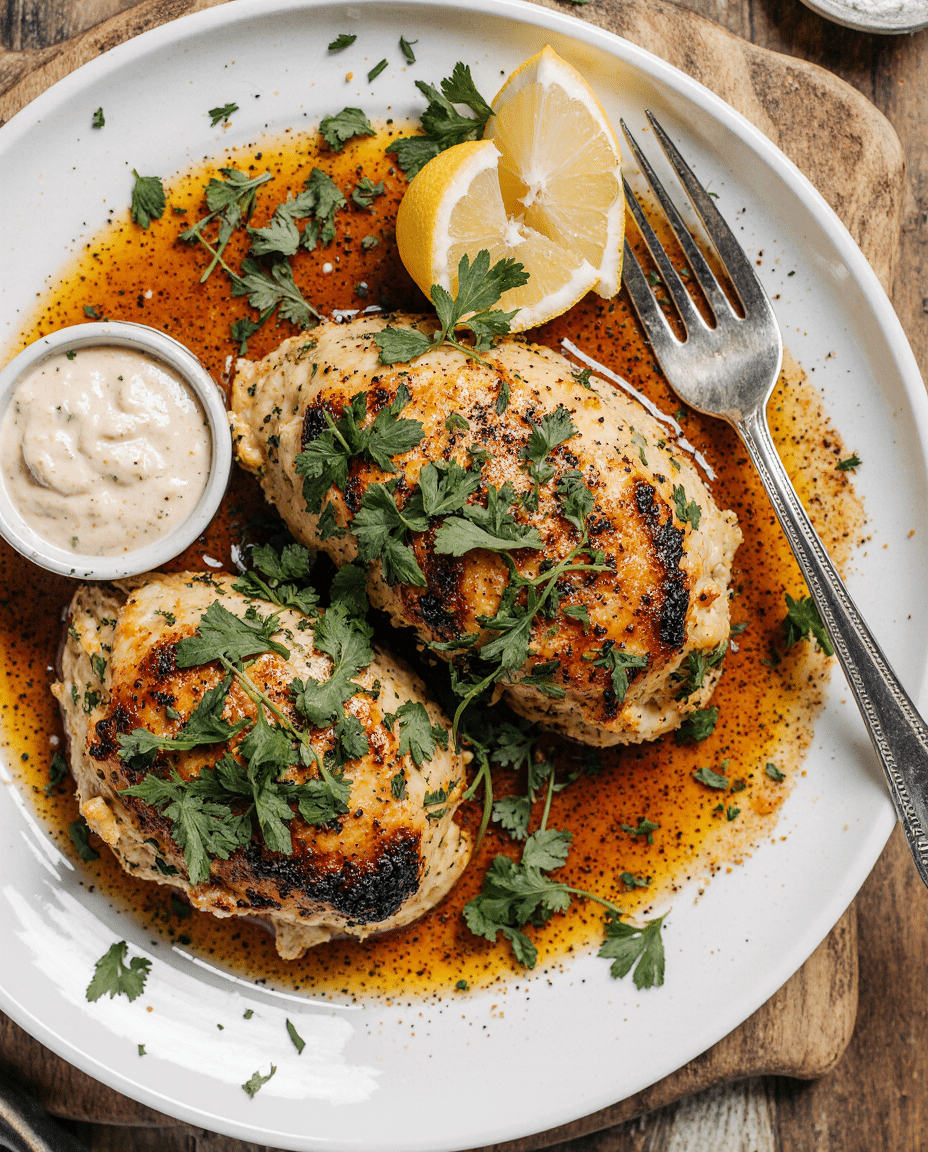This Middle Eastern Herb Chicken is a crowd-pleasing favorite for Labor Day gatherings, offering bold flavors inspired by traditional Levantine and Persian cuisine. Marinated in a vibrant blend of fresh herbs, garlic, lemon, and warm spices, the chicken is then grilled or roasted to juicy perfection.
FULL RECIPE
Ingredients
- 2 pounds boneless, skinless chicken thighs (or breasts)
- 1/2 cup fresh parsley leaves, chopped
- 1/2 cup fresh cilantro leaves, chopped
- 1/4 cup fresh mint leaves, chopped
- 4 cloves garlic, minced
- 1 tablespoon ground cumin
- 1 tablespoon ground coriander
- 1 teaspoon ground turmeric
- 1 teaspoon paprika
- 1 teaspoon ground black pepper
- 1 1/2 teaspoons salt
- 1/4 cup fresh lemon juice
- 1/4 cup olive oil
- Zest of 1 lemon
- 1 small red onion, finely chopped (optional)
- Yogurt or tahini sauce, for serving (optional)
Directions
- In a large mixing bowl, combine chopped parsley, cilantro, mint, garlic, cumin, coriander, turmeric, paprika, pepper, and salt.
- Stir in lemon juice, lemon zest, and olive oil to create a thick herb marinade.
- Add the chicken pieces to the bowl and coat them thoroughly in the marinade. For best flavor, cover and refrigerate for at least 4 hours or overnight.
- Preheat a grill to medium-high heat or preheat your oven to 400°F (200°C).
- If grilling, cook chicken for 5–7 minutes per side until nicely charred and the internal temperature reaches 165°F (74°C).
- If roasting, place the marinated chicken on a baking sheet lined with parchment paper and cook for 25–30 minutes or until fully cooked.
- Optional: Add chopped red onion to the marinade or sprinkle over cooked chicken for extra sharpness and texture.
- Let chicken rest for 5 minutes before serving. Serve with yogurt or tahini sauce and a side of grilled vegetables or rice.
Nutrition Facts
- Calories: 290
- Protein: 27g
- Total Fat: 18g
- Saturated Fat: 3g
- Carbohydrates: 3g
- Fiber: 1g
- Sugars: 1g
- Sodium: 590mg
- Cholesterol: 105mg
Flavor Profile of Middle Eastern Herb Chicken
Middle Eastern Herb Chicken boasts a vibrant and aromatic flavor profile defined by the harmonious blend of fresh herbs like parsley, cilantro, and mint. These bright herbs are complemented by warm spices such as cumin, coriander, turmeric, and paprika, which add depth and a subtle earthiness. The fresh lemon juice and zest bring a zesty tang that balances the richness of olive oil and the chicken itself. The resulting taste is both refreshing and complex, evoking the rich culinary traditions of the Middle East while remaining accessible and crowd-pleasing.
Health Benefits of the Ingredients
This recipe is not only delicious but also packs several health benefits. Fresh herbs like parsley and cilantro are rich in antioxidants and vitamins A, C, and K, which support immune function and skin health. Turmeric, a key spice here, contains curcumin known for its anti-inflammatory properties. Olive oil is a heart-healthy fat, known to improve cholesterol levels and reduce inflammation. Chicken thighs, while slightly higher in fat than breasts, provide a good source of protein essential for muscle repair and overall body function.
Variations and Adaptations
The recipe can easily be adapted to suit different dietary preferences and ingredient availability. For a leaner option, chicken breasts can replace thighs, although they require careful cooking to avoid drying out. Vegetarians can use firm tofu or cauliflower steaks, marinated and grilled similarly. You can also experiment by adding other herbs like oregano or rosemary for a twist. Adjusting the spice levels or adding a touch of chili flakes can bring more heat for those who prefer a spicier dish.
Cooking Techniques and Tips
Marinating the chicken for at least four hours is crucial to allow the flavors to penetrate deeply and tenderize the meat. Grilling is the preferred method as it imparts a smoky char that enhances the dish’s complexity. However, oven roasting is an excellent alternative that delivers juicy and evenly cooked chicken. It is essential to monitor internal temperature to ensure the chicken is cooked safely without drying out. Resting the chicken after cooking allows juices to redistribute, making every bite moist and flavorful.
Serving Suggestions
Middle Eastern Herb Chicken pairs wonderfully with a variety of side dishes. Traditional options include basmati or jasmine rice infused with saffron or turmeric for added color and aroma. Grilled vegetables like zucchini, eggplant, and bell peppers complement the herbaceous flavor perfectly. Flatbreads or pita can be served alongside to scoop up any juices or sauce. For a fresh touch, a simple cucumber and tomato salad dressed with lemon and olive oil brightens the plate and adds a cooling contrast.
Sauces and Condiments to Enhance the Dish
While the chicken is flavorful on its own, serving it with creamy sauces like yogurt-based tzatziki or tahini sauce elevates the experience. These condiments add a rich, cooling element that balances the spices and herbs. A drizzle of garlic lemon sauce or a sprinkle of sumac also works beautifully to enhance the citrusy notes. For those who enjoy a bit of heat, a harissa or spicy chili sauce can be served on the side to customize each bite.
Cultural Significance and Origins
This herbaceous chicken draws inspiration from Levantine and Persian cuisines, where fresh herbs and bold spices are fundamental. Herb-based marinades are a hallmark of Middle Eastern cooking, showcasing the region’s love for fresh, vibrant ingredients. The use of turmeric and cumin highlights the spice trade history that has influenced the cuisine over centuries. Serving this dish at gatherings and celebrations connects people to centuries-old culinary traditions and the communal joy of sharing flavorful meals.
Storage and Leftover Tips
Proper storage ensures that leftover Middle Eastern Herb Chicken remains tasty and safe to eat. It should be cooled quickly after cooking and stored in an airtight container in the refrigerator for up to 3-4 days. When reheating, gentle warming in a skillet or oven helps preserve moisture better than microwaving. Leftovers can also be shredded and used in wraps, salads, or grain bowls for quick, flavorful meals. Freezing is an option, but texture may change slightly, so it’s best consumed within one month.
Nutritional Information and Dietary Considerations
This recipe is rich in protein and healthy fats, making it a balanced meal choice. It is naturally gluten-free and can easily be made dairy-free by omitting yogurt-based sauces. The moderate sodium content can be reduced by adjusting the amount of added salt or using low-sodium spices. It fits well into paleo, keto, and Mediterranean diet plans. Including fresh herbs and olive oil enhances the overall nutrient density, supporting heart health, digestion, and inflammation reduction.
Pairing Beverages with Middle Eastern Herb Chicken
Pairing beverages thoughtfully can elevate the dining experience. For an alcohol option, a crisp, dry white wine such as Sauvignon Blanc or a light red like Pinot Noir complements the herbaceous and citrus notes. Non-alcoholic choices include sparkling water infused with lemon or mint, or a lightly sweetened hibiscus iced tea, which echoes the floral and fresh flavors of the dish. For a traditional touch, try serving with a glass of ayran, a salted yogurt drink popular in Middle Eastern countries.
Conclusion
Middle Eastern Herb Chicken is a delicious and versatile dish that brings vibrant flavors and health benefits to the table. Its fresh herb marinade, aromatic spices, and zesty lemon make it a standout choice for any occasion, especially festive gatherings like Labor Day. With simple adaptations and thoughtful pairings, it appeals to a wide range of tastes and dietary needs.






